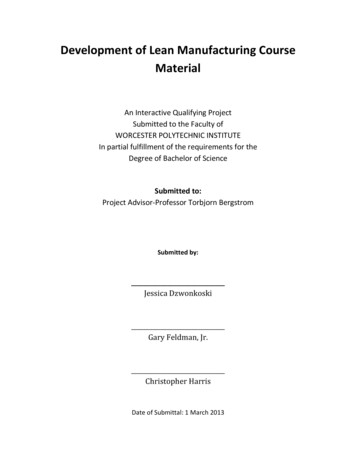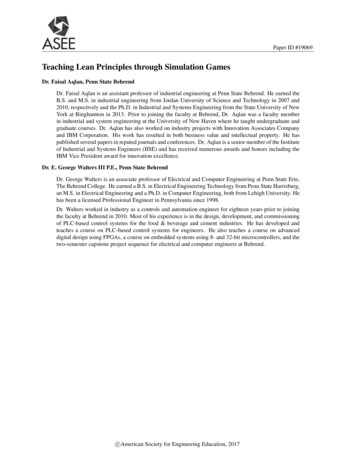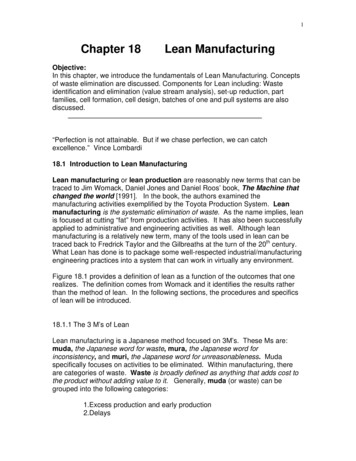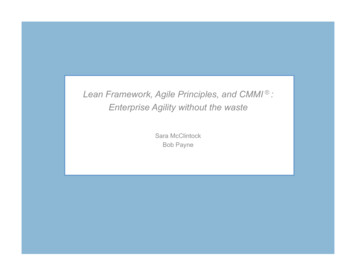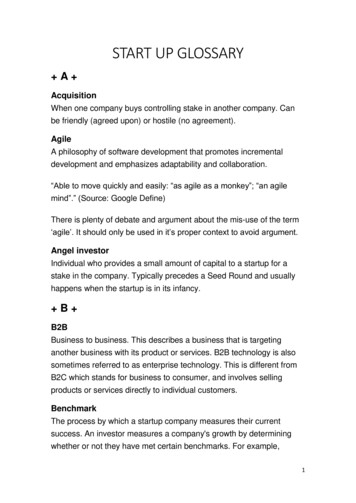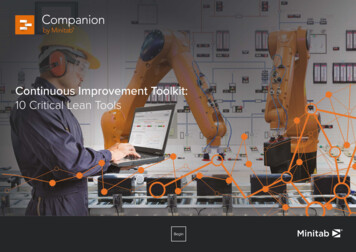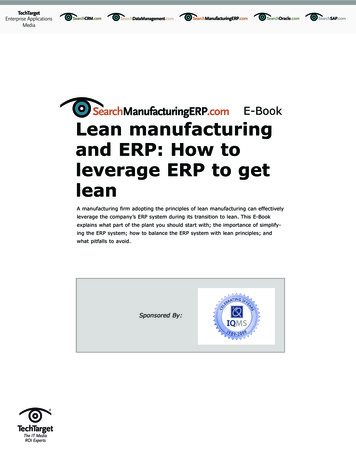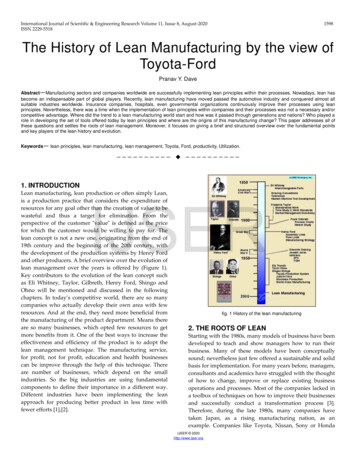
Transcription
International Journal of Scientific & Engineering Research Volume 11, Issue 8, August-2020ISSN 2229-55181598The History of Lean Manufacturing by the view ofToyota-FordPranav Y. DaveAbstract—Manufacturing sectors and companies worldwide are successfully implementing lean principles within their processes. Nowadays, lean hasbecome an indispensable part of global players. Recently, lean manufacturing have moved passed the automotive industry and conquered almost allsuitable industries worldwide. Insurance companies, hospitals, even governmental organizations continuously improve their processes using leanprinciples. Nevertheless, there was a time when the implementation of lean principles within companies and their processes was not a necessary and/orcompetitive advantage. Where did the trend to a lean manufacturing world start and how was it passed through generations and nations? Who played arole in developing the set of tools offered today by lean principles and where are the origins of this manufacturing change? This paper addresses all ofthese questions and settles the roots of lean management. Moreover, it focuses on giving a brief and structured overview over the fundamental pointsand key players of the lean history and evolution.Keywords— lean principles, lean manufacturing, lean management, Toyota, Ford, productivity, Utilization.—————————— ——————————1. INTRODUCTIONIJSERLean manufacturing, lean production or often simply Lean,is a production practice that considers the expenditure ofresources for any goal other than the creation of value to bewasteful and thus a target for elimination. From theperspective of the customer "value" is defined as the pricefor which the customer would be willing to pay for. Thelean concept is not a new one, originating from the end of19th century and the beginning of the 20th century, withthe development of the production systems by Henry Fordand other producers. A brief overview over the evolution oflean management over the years is offered by (Figure 1).Key contributors to the evolution of the lean concept suchas Eli Whitney, Taylor, Gilbreth, Henry Ford, Shingo andOhno will be mentioned and discussed in the followingchapters. In today’s competitive world, there are so manycompanies who actually develop their own area with fewresources. And at the end, they need more beneficial fromthe manufacturing of the product department. Means thereare so many businesses, which opted few resources to getmore benefits from it. One of the best ways to increase theeffectiveness and efficiency of the product is to adopt thelean management technique. The manufacturing service,for profit, not for profit, education and health businessescan be improve through the help of this technique. Thereare number of businesses, which depend on the smallindustries. So the big industries are using fundamentalcomponents to define their importance in a different way.Different industries have been implementing the leanapproach for producing better product in less time withfewer efforts [1],[2].fig. 1 History of the lean manufacturing2. THE ROOTS OF LEANStarting with the 1980s, many models of business have beendeveloped to teach and show managers how to run theirbusiness. Many of these models have been conceptuallysound; nevertheless just few offered a sustainable and solidbasis for implementation. For many years before, managers,consultants and academics have struggled with the thoughtof how to change, improve or replace existing businessoperations and processes. Most of the companies lacked ina toolbox of techniques on how to improve their businessesand successfully conduct a transformation process [3].Therefore, during the late 1980s, many companies havetaken Japan, as a rising manufacturing nation, as anexample. Companies like Toyota, Nissan, Sony or HondaIJSER 2020http://www.ijser.org
International Journal of Scientific & Engineering Research Volume 11, Issue 8, August-2020ISSN 2229-5518started to gain market leadership not only in the Japanesemarket but also in North America and Europe. The suddenand rapid rise of these companies set a quest for othermarket players, consultants and academics to find out howthese companies designed, implemented and operated theirmanufacturing systems. These processes were to be called“lean production” processes. The origins of lean can betraced back to the American fears that the Japanesemanufacturing companies within the car industry wouldtake over and gain an unbeatable competitive advantage.These fears drove academics and Western competitors toconduct a series of benchmarking activities in order toreach the roots of the Japanese success. The first resultswere published altogether in the publication “The Machinethat Changed the World by Womack, Jones and Roos” in1990. For Western manufacturers this text provided the firstwritten data concentrating on the Japanese success and onthe huge gaps they would have to overcome in order toreach the Japanese success. The authors found the Japanesemanufacturing model to use not only less effort, but alsoless of any resource invested in the manufacturing circle:fewer inventories, less space, less capital [4].1599in order to make every piece right. This was due to currenttechnology at the time, which did not allow the processingof hard metals. The army but accepted the costs but theclients did not. Yet, no armories were concerned with whatwas happening between processes, how many multipleprocesses were taking place in order, how the chainprocesses functions as a system and how each worker wentabout the task.This operation changed at the end of the 1890’s with workfrom the first industrial engineers. A representative of theseengineers was Frederick W. Taylor. Taylor focused onanalyzing workers individually and their job methods. Theresult of this analysis was Time Study and StandardizedWork. He introduced his ideas in a new management classcalled, “Scientific Management” or “Taylorism.” The mainpurpose of his ideas was economic efficiency improvement,especially in the area of productivity [6]. The title of thispractice was controversial because the idea of introducingthe science in management was revolting. Taylor ignoredthe attitude of those around him, focusing on the workersfor better analysis and process time reduction. Shortly afterTaylor’s Time Study another representative figure, FrankGilbreth, added his contribution into Lean history withMotion Study and Process Maping. Apart from Taylor’sphilosophy, efficiency by reducing the length of theprocesses, Gilbreth, through Motion Study, intendedreducing the workers movements during the productionprocess (ergonomy). In his vision Gilbreth was after theworkers wellbeing, while Taylor was after the profit.Gilbreth’s second contribution, Process Maping, focused onall the process elements, even on non-value added ones andwhich usually were classifications of official elementswithin the process. The main benefits of Process Mapingare: waste exposure, revealing the process-flow, definingand standardization, and encouragement towards a betterunderstanding of the processes [7].IJSER3. THE EVOLUTION OF LEAN MANAGEMENT– A CULTURAL TRACEThe evolution and history of lean management can betraced back using different determinants. Nevertheless, thefollowing chapter focuses on offering a cultural standpointof the history of lean management over the years.3.1. The American contributionEli Whitney and his concept of interchangeable parts madethe first step in the Lean production development and Justin Time (JIT). He became famous after inventing the cottongin, but this was a minor accomplishment compared withthe development of interchangeable parts, a concept thatwould later become the basis of industrial evolution [5]. Itmust be known that not Whitney created this concept ofinterchangeable parts, but it is mentioned long before him,since the time of Chinese emperor Qin Shi Huangdi (221B.C.) who ordered the manufacturing of standardized partsfor the crossbows, parts that could be quickly changed onthe battlefield. Whitney improved this concept in 1799when he took a contract from the U.S. Army for themanufacture of 10,000 muskets, for the Quasi war, at theunbelievably low price of 13.40 each. The concept ofinterchangeable parts was later applied in companies asCadillac, Chrysler and this led to an increase in bothproduction volume and speed. With the evolution ofinterchangeable parts concept in America, until 1850, all thearmoires were producing standardized metal parts forstandardized weapons but with large effort of manual workF. Gilbreth’s study was closely supported by his wife, LilianGilbreth, through the introduction of psychology in thisfield. By adding psychology to the mixture of ideas, Lilianstudied worker motivation and how it affected attitudesand process results. F.W. Taylor, Frank and Lilian Gilbreth,alongside other contributors, created the idea of“eliminating waste.” This idea stands as one of theprinciples in JIT production system and Lean production.Henry Ford, the founder of Ford Motor Company, made amajor step in the evolution of Lean. Ford’s vision was tobuild a car for the great multitude. Thus the electrificationof steam engine and the new production and managementtechniques, allowed him to take the 20th centuryproduction to a whole new level and produce the famousIJSER 2020http://www.ijser.org
International Journal of Scientific & Engineering Research Volume 11, Issue 8, August-2020ISSN 2229-5518“T Model” in only 93 minutes [8]. Therefore, starting with1910, Ford together with his right-hand, vice presidentCharlie Sorensen, created the first Intelligent ProductionStrategy. They took all the elements from the productionsystem—people, machines, tools and products—andarranged them in a continuous system for the T Modelproduction. We can conclude that this was the firstsystematic approach of a process-flow. Ford’s managementapproach was strongly influenced by the F.W. Taylor’stheory of Scientific Management, published in 1911.Although Scientific Management allowed Ford to increasehis productivity, this production system wouldn’t surviveagainst the future Japanese competition. Ford’saccomplishments had a major impact on competitors,resulting in many unsuccessful attempts from othercompanies. Failure was caused by the inability tounderstand the basic principles and apply Ford’s methods.3.2. The Japanese contributionWhile Ford’s mass production system prospered during theperiod economic growth in America, Toyota ProductionSystem (TPS) was proposing another system of standardsfor obtaining maximum economic efficiency with minimalresources. The TPS’s key was to eliminate any kind ofwaste. This meant any activity that didn’t add value to theproduct: overproduction, stocks, transport, waiting time,stocking space, maintenance/errors, and supply time. Theapproach of this basic TPS principle was made bycontinuous improvement of the standards. Significantdifferences between the two companies were the means bywhich they would alter the standards. Ford was using hisindustrial engineers to define work standards, while Toyotawas passing this responsibility to the workers in Gemba(the production area) [9]. Taiichi Ohno, Shigeo Shingo andEiji Toyoda developed the Toyota Production Systembetween 1948-1975; originally it is being called Just-In-TimeProduction. However, for a better understanding howToyota came to this system, the company must be analyzedfrom the beginning. In the first decades of the 20th century,the local automobile industry in Japan was poorlydeveloped, so the production was relatively small. Thischanged in 1925, at the same time with the entry of theJapanese market as automotive Ford Company and alsowith General Motors in 1927. U.S. automobile companies ina short time (to 1934) covered Japanese automobile demandwith 92%, while Toyota owned a percentage of only 3%.autumn of 1934, the first prototype of Toyota’s engine wasmanufactured. Also, Kiichiro encouraged the leadership tovisit American auto manufacturers in order to improveToyota’s mass production system with visualization. Allefforts made by Kiichiro culminated from the introductionof the first Model A1 car prototype in May 1935. However,all these efforts made by the Japanese seemed useless whencompared to the development of American the giants. TheAmerican domination ended in 1936 with the introductionof the Enterprise Law automobile which planned theclosing the Americans factories and subsidized three bigJapanese trucks producers companies: Toyota, Nissan andIsuzu. At this point the Japanese automobile industry hadto develop freely without falling behind of U.S. companies.Toyota tried to introduce the American mass productionsystem in the factory from Komoro. However, this systemhad to be adapted according to both that time period andthe existing production system. The intention was to usecreativity in the development of a Japanese productionsystem from a cultural and economic perspective. Theseefforts suffered resistance from employees, whom were stillguided by the traditional production techniques with theFord system.IJSERIn order to fix this situation, the Toyota automotive branch(Toyoda Automatic Loom Works Ltd. at the time and laterbecame Toyota Motor Co. Ltd.), led by Kiichiro Toyoda, theson of the founder of Toyota, Sakichi Toyoda. Heperformed research in automotive engines and in the1600The crucial moment in LEAN concept evolution was thedecision made by Toyota to improve productivity from theinside. This decision was made due to the financialsituation after the Second World War, which meantcancelling the modernizing of production equipment. Toachieve an internal improvement, Toyota combinedTaylorism elements (standardization) with specificcompany. These elements included production flow,multitasking and establishment of the production system.The results were better than expected. Production hadgrown so much that it reached overproduction. This lead toa production of waste, that TPS personally tried toeliminate and place the company into possible bankruptcy.The company solved this issue by delivering automobiles tothe American army during the Korean War. Another steptowards progression made by Toyota was the arrival of twogreat Quality Management parents in Japan: Edwards W.Deming (1950) and Joseph M. Juran (1954). Demingmadehimself known in Japan with top management instructionby introducing Statistic Quality Control (SQC) and definingthe famous “Deming circle”: Plan, Do, Check and Act. Inthe eyes of the Japanese, Deming was a hero by putting asolid foundation on Japanese quality [10]. Juran, the secondplayer on the Japanese quality scene, made his appearancein 1954 bringing essential contribution in the areas of: Defining the Quality Management System, whichis a basic requirement for every companyproducing material goods and services?IJSER 2020http://www.ijser.org
International Journal of Scientific & Engineering Research Volume 11, Issue 8, August-2020ISSN 2229-5518 1601Using the Pareto principal in control quality. Itmust be remembered the Pareto principal wascreated in 1906 by the Italian Vilfredo Pareto whoobserved that 20% of Italy s population owned80% of its territory.Non-quality cost study: “Juran Trilogy” definedquality components like planning, control andquality improvement [11].challenge nowadays remains the managerial question ofwhat tools and principles to use and how to apply them.Differences in culture, industry and infrastructures make itimpossible for managers worldwide to implement the samelean tools and principles that once worked in Japan. Theapproach must be held under continuous improvement andmust be tailored to the realities of each specific company,industry and country.At the end of the 1950s, Toyota introduced a stock gestationsystem named Kanban, in translation “card” which wassupposed to reduce the waste created in stocks [12]. As aresult of the TPS success, Toyota was supposed to invadethe American automobile market and place themselvesamongst top companies like Ford and General Motors.Another factor that contributed to Toyota s companydevelopment and the LEAN Management, was theJapanese engineer Shigeo Shingo. Shingo created the SMEDmethod and the “Non-Stock Production” system. Thissystem was created in 1975 and means cutting the strings ofthe stock products and the necessary space and their cost[13]. Single Minute Exchange of Die (SMED) is a methodapplied for the first time in Toyota Company and follows areduction in the setting time of equipment. The method wassuccessful, with the setting time being reduced from 1-2hours to just a few minutes. Related to this method is the “6Sigma” concept developed by Motorola in 1985, whichcame to the world s attention in 1995 when it wasintroduced by General Electric company via Jack Welch. 6Sigma improves process quality by identifying andeliminating defections.Currently in Europe the great promoters of thismanufacturing system are companies like Porsche orDaimler. Suppliers of these companies already entered theEastern European markets. Moreover, there is valid marketinformation about further investment strategies ofautomotive suppliers in countries from Eastern Europe.When looking at a country like Romania, the increasingconcerns of the industry for lean manufacturing isunderlined not only through the increasingly leanimplementations in manufacturing companies but alsothrough the emphasis on empirical research in this field.Higher education institutions in Romania and EasternEurope are adding lean management disciplines to theircurricula in order to educate specialists. Last but not least,the number of conferences in the area of lean managementand manufacturing, as well as the number of consultancycompanies is increasing rapidly throughout all EasternEurope. IJSER5. REFERENCES[1][2]4. CONCLUSIONSComparing the Japanese and the American contributions,we can conclude that the American contribution resulted ina spectacular productivity growth and decrease in price.These two factors lead to wider product accessibility forcustomers. On the other hand, the Japanese contributionleads to the elimination of waste and reducer of resourceswithin the automotive industry. Lean nowadays, continuesto spread not only to every country worldwide, but hassettled its roots in Europe. Successful companies areadapting and implementing lean principles beyondmanufacturing. Despite the origins of lean manufacturingbeing the Japanese car and automotive industry, lean hasgathered appreciation not only worldwide but alsoindustry wide. Lean principles are spreading knowing noindustry barriers from logistics and distribution to retail,construction and even healthcare and governmentinstitutions. The goal is to improve the organizationalperformance on all operating levels by trying to eliminateall kinds of unneeded or wasteful activities. The biggest[3][4][5][6][7][8][9]IJSER 2020http://www.ijser.orgAICPA, “lean management techniques,” j. Account., no. Abril,pp. 34–41, 2016.M. Del Rocio Quesada Castro and J. G. A. Posada,“implementation of lean manufacturing techniques in thebakery industry in medellin,” gest. E prod., vol. 26, 27 no. 2,pp. 1–9, 2019.Rich Nick, Lean Evolution. Lessons from the Workplace,(Cambridge: University Press, 2006), 14-15.Rich Nick, Lean Evolution. Lessons from the Workplace,(Cambridge: University Press, 2006), 15.Strategosinc, “A Brief History of (Just-In-) Time”,http://www.strategosinc.com/just in time.htm(accessedOctober 11, agement (accessed October 11, 2013).Strategosinc, “How To Chart (Map) Your Process”,http://www.strategosinc.com/process map example.htm(accessed October 11, 2013).Mentalfloss, “The Electric Shock: Electric Cars Pre-Date 52/electricshock-electric-cars-pre-date-civil-war (accessed October 11,2013).Clarke Constanze, Automotive Production Systems andStandardisation. From Ford to the Case of Merceds-Benz,(Heidelberg: Physica-Verlag, 2005), 88-111.
International Journal of Scientific & Engineering Research Volume 11, Issue 8, August-2020ISSN ://www.deming.org/theman/overview (accessed October11, rstudy.com/management-gurus/joseph-juran(accessed October 11, 2013).Clarke Constanze, Automotive Production Systems andStandardisation. From Ford to the Case of Merceds-Benz,(Heidelberg: Physica-Verlag, 2005), w.shingoprize.org/dr-shigeo-shingo.html (accessedOctober 11, 2013).IJSERIJSER 2020http://www.ijser.org1602
Manufacturing sectors and companies worldwide are successfully implementing lean principles within their processes. Nowadays, lean has become an indispensable part of global players. Recently, lean manufacturing have moved passed the automotive industr
